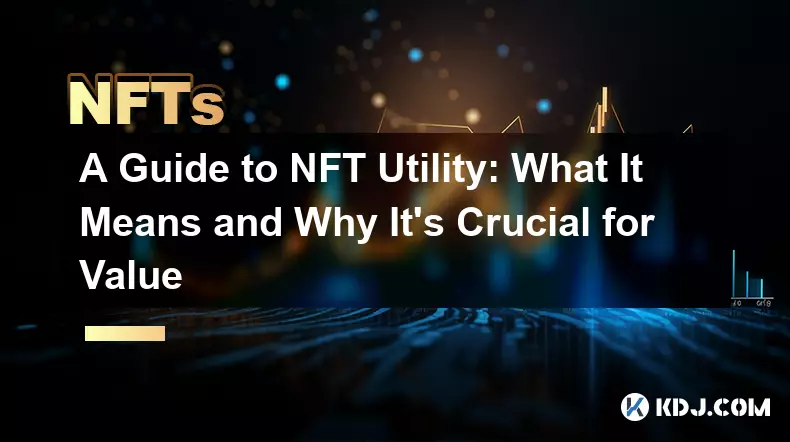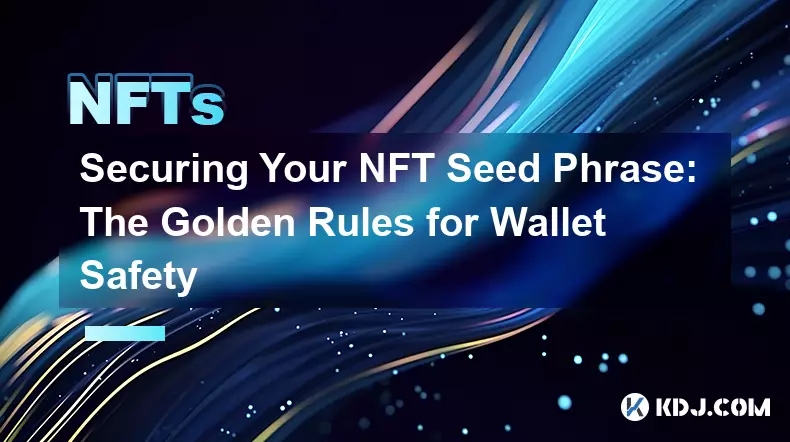-
 bitcoin
bitcoin $99177.955738 USD
-7.32% -
 ethereum
ethereum $3187.183061 USD
-12.38% -
 tether
tether $0.999809 USD
0.00% -
 xrp
xrp $2.117933 USD
-9.42% -
 bnb
bnb $906.710033 USD
-9.17% -
 solana
solana $149.367737 USD
-10.74% -
 usd-coin
usd-coin $0.999816 USD
0.01% -
 tron
tron $0.281498 USD
-0.38% -
 dogecoin
dogecoin $0.156292 USD
-8.00% -
 cardano
cardano $0.500744 USD
-10.19% -
 hyperliquid
hyperliquid $38.087358 USD
-4.58% -
 chainlink
chainlink $14.097831 USD
-8.54% -
 bitcoin-cash
bitcoin-cash $463.329916 USD
-9.22% -
 ethena-usde
ethena-usde $0.999078 USD
-0.01% -
 unus-sed-leo
unus-sed-leo $9.475862 USD
-0.79%
Understanding NFT Smart Contracts: A Security Guide for Collectors
NFT smart contracts are self-executing code on blockchains that govern token creation, ownership, and transfer, using standards like ERC-721 for interoperability.
Nov 05, 2025 at 06:36 am

What Are NFT Smart Contracts and How Do They Work?
1. NFT smart contracts are self-executing pieces of code deployed on blockchain networks like Ethereum, enabling the creation, ownership, and transfer of non-fungible tokens. These contracts define the rules for how an NFT behaves, including who can transfer it and under what conditions.
2. Each NFT is typically minted through a standardized interface such as ERC-721 or ERC-1155, which ensures compatibility with wallets, marketplaces, and other decentralized applications. The contract holds metadata, token IDs, and ownership records that are immutable once recorded on-chain.
3. When a user purchases an NFT, the smart contract verifies the transaction, updates ownership in its internal registry, and logs the event on the blockchain. This process eliminates intermediaries and reduces counterparty risk, but places full responsibility on users to understand the underlying code.
4. Smart contracts do not inherently store media files; instead, they reference external URLs where images or videos are hosted. This introduces risks if those links become inactive or are altered post-mint, potentially leading to broken or swapped content.
5. Collectors should verify whether the metadata is stored on decentralized systems like IPFS or Arweave, which offer greater permanence than centralized servers. Contracts pointing to mutable URLs controlled by creators may allow unauthorized changes to artwork or attributes.
Red Flags in NFT Smart Contracts
1. One major warning sign is a contract that grants excessive privileges to the deployer, such as the ability to freeze transfers, mint unlimited copies, or alter metadata at will. Such backdoor controls undermine the principle of decentralization and expose collectors to manipulation.
2. Unverified contracts on block explorers like Etherscan present significant danger. If the source code isn’t publicly audited, malicious functions could be hidden, allowing developers to drain funds or revoke ownership without notice.
3. Some contracts include royalty override mechanisms that let marketplaces bypass creator payouts. While this affects creators more directly, it signals poor governance standards that may reflect broader security oversights impacting buyer protections.
4. High gas fees during interactions might indicate inefficient or bloated code, but abnormally low execution costs could suggest missing validation steps, making the contract vulnerable to exploits like reentrancy attacks or spoofed mints.
5. Contracts with time-locked features or conditional access require extra scrutiny. Hidden expiration dates or unlock conditions could render an NFT unusable or devalued after a certain date, especially if these terms aren’t clearly disclosed off-chain.
How to Audit and Verify NFT Contracts Safely
1. Always check the contract address on a trusted block explorer and confirm it has been verified. Look for green checkmarks indicating matched source code, and review any published audit reports from reputable firms like CertiK or OpenZeppelin.
2. Use tools like Solidity Visual Developer or Tenderly to simulate transactions and inspect function behavior before interacting. Testing approvals, transfers, and reveals in a safe environment helps uncover unexpected logic flaws.
3. Examine the permissions model within the contract—functions labeled onlyOwner should be limited to essential administrative tasks. Widespread use of modifiers like onlyOwner for core functionalities suggests centralization risks.
4. Review past transactions and wallet activity linked to the contract. Sudden large-scale minting events or suspicious transfers from the deployer’s wallet may indicate pump-and-dump schemes or insider allocations.
5. Cross-reference the project’s official communications with on-chain data. Discrepancies between promised features (like rarity traits) and actual contract implementation can reveal misleading marketing or outright fraud.
Frequently Asked Questions
Can someone else modify the artwork linked to my NFT?Yes, if the smart contract uses a mutable URI and the developer retains control over the server hosting the image, they can technically change the associated file. This is why permanent storage solutions like IPFS with locked hashes are preferred.
What happens if the NFT marketplace shuts down?The NFT itself remains on the blockchain even if the marketplace closes. However, you may lose easy access to viewing or trading it unless alternative platforms support the same contract standard and metadata format.
How do I know if an NFT contract has been hacked before?Check historical transaction logs for unusual activity such as mass withdrawals, emergency withdrawals, or contract self-destruct calls. Platforms like DeFi Llama or Immunefi track known breaches and bounty claims related to specific contracts.
Is owning an NFT the same as owning the copyright?No, purchasing an NFT typically grants ownership of the token, not the intellectual property behind the content. Unless explicitly stated in the contract or accompanying legal agreement, commercial rights remain with the original creator.
Disclaimer:info@kdj.com
The information provided is not trading advice. kdj.com does not assume any responsibility for any investments made based on the information provided in this article. Cryptocurrencies are highly volatile and it is highly recommended that you invest with caution after thorough research!
If you believe that the content used on this website infringes your copyright, please contact us immediately (info@kdj.com) and we will delete it promptly.
- Token Security, Startups, and 2025: A New Era of AI Security
- 2025-11-05 23:00:01
- Crypto Cloud Mining: Trustworthy Sites and Trends to Watch in 2025
- 2025-11-05 23:05:01
- Bitcoin Price Plunge: Long-Term Holders Dump $45 Billion!
- 2025-11-05 23:25:01
- AI-Powered Ascent: S&P 500 Valuations in the Age of Artificial Intelligence
- 2025-11-05 22:50:02
- Nebius, Token Factory, and AI Inference: A New Era of Open-Source AI?
- 2025-11-05 23:10:02
- Galaxy's Take: Zcash as the Bitcoin Alternative You Didn't Know You Needed
- 2025-11-05 23:55:01
Related knowledge

NFT Portfolio Tracking: The Best Tools to Manage Your Investments
Nov 04,2025 at 11:04pm
NFT Portfolio Tracking: Why It Matters in the Digital Asset Space1. The rapid expansion of the NFT market has made it essential for collectors and inv...

The Complete Guide to NFT Whitelists: Strategy for Gaining Access
Nov 03,2025 at 02:36pm
Decentralized Exchanges Gain Momentum in 20241. Decentralized exchanges (DEXs) have seen a significant rise in trading volume, surpassing centralized ...

Verifying NFT Authenticity: A Checklist to Avoid Fakes and Scams
Nov 01,2025 at 03:55pm
Understanding the Foundations of NFT Verification1. Every NFT is built on a blockchain, most commonly Ethereum, Solana, or Polygon. The blockchain pro...

Polygon (Matic) NFT Guide: Why It's a Top Choice for Low-Fee Trading
Nov 02,2025 at 06:36pm
Bitcoin's Role in Decentralized Finance1. Bitcoin remains the cornerstone of decentralized finance, serving as a primary store of value within the cry...

A Guide to NFT Utility: What It Means and Why It's Crucial for Value
Nov 01,2025 at 12:54am
Understanding NFT Utility in the Digital Economy1. NFT utility refers to the functional value that a non-fungible token provides beyond its existence ...

Securing Your NFT Seed Phrase: The Golden Rules for Wallet Safety
Nov 03,2025 at 09:54pm
Understanding the Importance of Your NFT Seed Phrase1. The seed phrase, typically a sequence of 12 or 24 words, acts as the master key to your digital...

NFT Portfolio Tracking: The Best Tools to Manage Your Investments
Nov 04,2025 at 11:04pm
NFT Portfolio Tracking: Why It Matters in the Digital Asset Space1. The rapid expansion of the NFT market has made it essential for collectors and inv...

The Complete Guide to NFT Whitelists: Strategy for Gaining Access
Nov 03,2025 at 02:36pm
Decentralized Exchanges Gain Momentum in 20241. Decentralized exchanges (DEXs) have seen a significant rise in trading volume, surpassing centralized ...

Verifying NFT Authenticity: A Checklist to Avoid Fakes and Scams
Nov 01,2025 at 03:55pm
Understanding the Foundations of NFT Verification1. Every NFT is built on a blockchain, most commonly Ethereum, Solana, or Polygon. The blockchain pro...

Polygon (Matic) NFT Guide: Why It's a Top Choice for Low-Fee Trading
Nov 02,2025 at 06:36pm
Bitcoin's Role in Decentralized Finance1. Bitcoin remains the cornerstone of decentralized finance, serving as a primary store of value within the cry...

A Guide to NFT Utility: What It Means and Why It's Crucial for Value
Nov 01,2025 at 12:54am
Understanding NFT Utility in the Digital Economy1. NFT utility refers to the functional value that a non-fungible token provides beyond its existence ...

Securing Your NFT Seed Phrase: The Golden Rules for Wallet Safety
Nov 03,2025 at 09:54pm
Understanding the Importance of Your NFT Seed Phrase1. The seed phrase, typically a sequence of 12 or 24 words, acts as the master key to your digital...
See all articles










































































